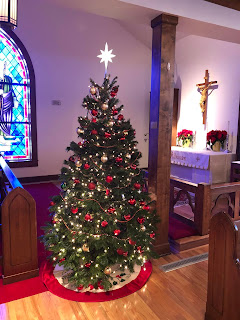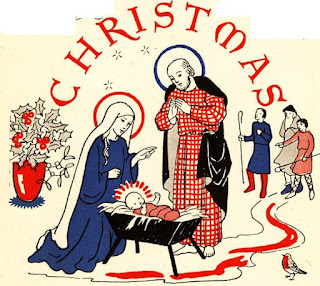ALMIGHTY God, who hast given us thy only begotten Son to take our nature upon him, and as at this time to be born of a pure Virgin; Grant that we being regenerate, and made thy children by adoption and grace, may daily be renewed by thy Holy Spirit; through the same our Lord Jesus Christ, who liveth and reigneth with thee and the same Spirit ever, one God, world without end. Amen.
This site is dedicated to the traditional Anglican expression of the One, Holy, Catholic and Apostolic Church of Our Lord Jesus Christ. We profess the orthodox Christian Faith enshrined in the three great Creeds and the Seven Ecumenical Councils of the ancient undivided Church. We celebrate the Seven Sacraments of the historic Church. We cherish and continue the Catholic Revival inaugurated by the Tractarian or Oxford Movement. Not tepid centrist Anglicanism.
Friday, December 24, 2021
Wednesday, December 22, 2021
Tuesday, December 21, 2021
The Presiding Bishop's Christmas Message
The sacraments are outward and visible signs of inward and spiritual grace, ordained by Christ Himself, as means whereby we receive the same, and pledges to assure us thereof. The principle of the sacraments is found in the whole Bible, and in its fulness in the New Testament, that is, in the Incarnation of the Word of God, Jesus Christ. God becomes Man so that man may become one with God. God assumes human nature in the Incarnation, all that pertains to man, human body, mind, soul, and spirit, so that human nature may be redeemed, sanctified, and glorified by God to share in the divine life.
God takes our human nature, divinises it, and gives it back to us in the sacraments, so that we may, in our own human nature, partake of God Himself. As the Fathers love to say: 'we become by grace what God is by nature.'
The Incarnation and the Sacraments are two expressions of one reality: God the Son becomes Man, and then takes that Hypostatic Union, human flesh united to the Divine Word, and conveys it to the members of His own Mystical Body, the Church, in and through the Sacraments.
This is why the Great Tradition teaches that the pre-eminent Sacraments of Holy Baptism and the Holy Eucharist are generally necessary to salvation: Baptism, as the Sacrament of New Birth, mystically unites us to the crucified and risen Christ and regenerates our human nature into the nature of the Son of God (St John 3.3-7, Romans 6.1-11, Galatians 3.22-29). We become children of God and members of Christ's Body in Baptism.
The Holy Eucharist, the Sacrament of the Lord's Body and Blood, nourishes us with the human nature and divinity of Christ unto everlasting life (St John 6.53-59, 1 Corinthians 10.14-22, 11.23-34). Our Lord's True Body and True Blood are really contained, really given, and really eaten, objectively, under the forms of bread and wine in the Eucharist, after an heavenly and supernatural manner, so that we may partake of Christ's human nature and be recreated by it.
Ours is a 'body religion,' the Church as the Body of Christ, the Religion of the Incarnation, which is made a reality in us sacramentally. There is only One Body of Christ, in the Incarnation, in the Eucharist, and in the Church, us.
Thus, man is a sacrament. Man is a composite being of body and soul, an outward and visible sign of an inward and spiritual reality. Man's outward sign is his body; man's inward and spiritual reality is his soul and spirit. Mankind is a living sacrament: he simultaneously exists as material and spiritual, physical and supernatural, united together in one cohesive entity. When the soul leaves the body, death occurs, which is for man an unnatural state not intended by God in His first creation of us. Man was created to be forever alive, forever immortal in a sacramental state.
Monday, December 20, 2021
Silver Jubilee of Priestly Ordination
Sunday, December 19, 2021
The Continuing Church
Recently I discovered that Father Alfred Hope Patten, the restorer of the Shrine of Our Lady of Walsingham, prophesied the formation of the Continuing Church years before it happened: 'I am more and more coming to the opinion that Catholics in communion with Canterbury must consider the example of the Wee Frees of the Scots - the day cannot be far off when some of us will have to go out into the desert - and there prove our catholicity - after which perhaps a united body may be formed as a link.'
Friday, December 17, 2021
Christmas 2021 - Saint Barnabas Dunwoody
SAINT BARNABAS CATHEDRAL, DUNWOODY:
Our 2021 Christmas Mass schedule...
Christmas Eve, Friday 24th December
6.30pm - Choral Presentation and Congregational Carol Singing
7pm - Family Eucharist
9.30pm - Choral Presentation and Congregational Carol Singing
10pm - Solemn High Mass
Christmas Day, Saturday 25th December
10am - Sung Mass
Let us keep MASS in Christmas! God bless you!
Sunday, December 12, 2021
Tuesday, December 07, 2021
Thursday, December 02, 2021
Saturday, November 27, 2021
Blessed Advent!
ALMIGHTY God, give us grace that we may cast away the works of darkness, and put upon us the armour of light, now in the time of this mortal life, in which thy Son Jesus Christ came to visit us in great humility; that in the last day, when he shall come again in his glorious majesty to judge both the quick and the dead, we may rise to the life immortal, through him who liveth and reigneth with thee and the Holy Ghost, now and ever. Amen.
Tuesday, November 09, 2021
Tuesday, November 02, 2021
Monday, November 01, 2021
Sunday, October 17, 2021
Sunday, October 03, 2021
Sunday, September 19, 2021
Saturday, September 18, 2021
Monday, September 13, 2021
Sunday, September 05, 2021
Tuesday, August 17, 2021
The Assumption of Our Lady
All Christians have believed in the Assumption in one form or another since the patristic age, a belief reinforced by the lack of relics of the Holy Virgin, and the veneration of the place of her repose and glorification, going back to the beginnings of church-building and public liturgies after Roman persecution. Our Lady died and was physically raised and glorified after death as a sign and promise of our own resurrection and glorification on the Last Day. Mary's Assumption is the foretaste of the assumption of the whole Church. What Jesus does for her, He will do for us.
Although the Assumption or Dormition is a consentient and universal part of ancient Tradition, it does not stand on the same level as the Trinity, the Incarnation, the Virginal Conception and Birth of Our Lord, or the Resurrection of Christ, and thus it is not acknowledged either by Anglicans or Eastern Orthodox as an essential article of the Faith and Creeds. Neither Anglicans nor Eastern Orthodox desire to dogmatise the mysteries of Our Lord's Mother. These are mysteries of love. Therefore we do not recognise the necessity of believing any version of this ancient doctrine for eternal salvation and it is not accounted a dogma, or revealed truth necessary for salvation, of the Gospel. But it is a beautiful and comforting belief which points squarely to the glory of Christ's Resurrection and its power to save all who are united to Him.
An Anglican is free to believe or not believe in Our Lady's corporeal Assumption, but all agree she died and went to Heaven! And that heaven-going, hers and ours, is what we celebrate on 15th August.
Thursday, August 12, 2021
Sunday, August 08, 2021
Monday, August 02, 2021
Changing Leadership, Changeless Faith
On the morning of July 21, 2021, the 53rd Annual Synod of the Diocese of the Eastern United States (DEUS) convened in Atlanta, Georgia, the Most Rev’d Walter H. Grundorf, D.D., presiding. This synod was significant due to Bishop Grundorf’s retirement, which would take effect at the close of the synod. Bishop Grundorf became Ordinary of the Diocese in 1995 and has served with distinction for all these years as Chief Pastor of the Diocese. Bishop Grundorf has also served as Presiding Bishop of the Anglican Province of America since its erection in 1998.
On the evening of July 22, 2021, the clergy and laity of the Anglican Province of America (APA) gathered at St. Barnabas Cathedral in Dunwoody, Georgia for the Installation and Enthronement of the Most Rev’d Chandler H. Jones, SSC, as the new Bishop Ordinary of the DEUS. Bishop Grundorf was the Chief Institutor, assisted by Co-institutors, Archdeacons Mark Menees and Michael Ward.
On Friday morning, July 23, 2021, the 10th Synod of the APA ratified the House of Bishops’ election of Bishop Jones as Presiding Bishop. Bishop Jones was installed as Presiding Bishop at the closing Eucharist of the APA Synod that same morning.
Sunday, August 01, 2021
Enid Chadwick Images
Two hand-painted images from the famous Anglo-Catholic artist Enid Chadwick which have come into the possession of our family - Saint Thérèse of Lisieux and Saint Monica.
Apostolic Succession
What Apostolic Succession looks like... the end of the 2021 Provincial Synod of the Anglican Province of America.
Sunday, July 25, 2021
-
Following on the intriguing discussion at The Continuum , below is the carefully-researched essay by Father John Jay Hughes found in his 197...
-
Being a Tractarian, ressourcement, patristically-minded, first millennial, conciliarist, philorthodox kind of Anglo-Catholic, I have always ...
-
Another liturgical tradition from the Orthodox Church for one's contemplation, a section of THE OFFICE FOR THE RECEPTION OF CONVERTS: Wh...





















































